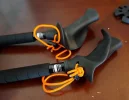Hi, Lynne; I appreciate your question. My answer is not a debate on how or if straps should be used, only about why
I don't use them.

I have been a user of trekking poles for a couple of decades now. They have been used for tens of thousands of miles wilderness backpacking including my PCT and Colorado Trail thru hikes. I have also used them on 3 caminos, and they accompany my on my training hikes on my 5 day/week routine in the Central Washington Cascade Mountain foothills.
I mention the above to give you some context to my personal preference.
I do not disagree with your rationale for using straps. I am familiar with subjective claims made about using straps regarding the efficacy claims for straps vs no straps. I have examined the literature on the attempts to objectively measure and quantify the mechanical-physiological interface from the strap of the trekking pole, as it connects to a users supporting points at the hand through the arm and upper body.
I am writing the above so that you know I am aware of the stated benefits when using straps.
I do not know what it feels like for anyone else
but myself to use trekking poles with or sans straps. That leaves me with no basis by which to confirm or deny a user's subjective valuation of strap use.
1. Pressure on the hand grip. That can mean two different things. One is how hard you grasp the hand grip itself. The second type of pressure is how much force is applied to a point on the hand while using the pole to 'push off' with each step.
I never death grip the trekking pole. In fact i use the same exact looseness with my grip either with or without a strap. It takes minimal effort to keep the handle from slipping out of the hand; in fact I find that I only use my thumb and forefinger-middle finger to keep the handle in place. When the pole is not being loaded as I get ready to push off, it more dangles from my hand than it is firmly controlled.
When it comes time to push-off, my grip automatically shifts to include the other fingers. My grasping off the handle remains mostly loose, not at all tight. The grips themselves are formed, with an area of protrusion on the grip which 'organically' presses against the outer edge of my hand to take the loading pressure as I shove/push off.
I notice very little difference in efficiency or energy output between the straps and the no strap usage. if there is a noticeable difference, it would fractionally favor the strap use. However, the 'Pros' for using the strap are far outweighed by not having the straps due to the increased usability and flexibility that I have with the trekking poles.
While using straps, there has been several times when potential injury, and one actual injury has occured. On unstable or uneven terrain I have had occasion to slip while my wrists suffered strain because the pole was partially lodged upright. Most of the time, the trekking pole eventually slipped so that it released the severe momentary pressure on my wrist. One time, I suffered a severe sprain and ligament strain to the lower arm and wrist.
I cannot count how many times the tips of the poles have become unexpectedly wedged. My momentum did not allow me a to stop on a dime, meaning that when letting go of the pole the straps would still keep the pole attached to my body. Many times the pole would relent and break free. At least half a dozen times the pole was so firmly wedged, that as my momentum carried me forward with the strap attached, the tip of the pole snapped off. One time an entire lower segment of an adjustable pole snapped in two.
Without a strap, I can immediately release the pole and it remains undamaged. Or I do.
The most valuable usability feature with no strap, is the speed and ease with which I can shift a pole to the other hand when I want to grab a snack from my hipbelt pocket while walking, grab the water tube to locate it to my mouth and then to remove it, grab my camera to snap a photo, etc. I do not have to remove my hand from the strap or let the pole dangle from my hands while fiddling which can be a bit awkward and a potential tripping hazard if the pole dangles and catches on something.
My method of using tip protectors is to place them on the tips or to remove them based on the walking surface. On Camino it amazed me how often I would need to do this.
When I need to remove them quickly, I quickly shift one pole to join its sibling in the other hand. With the free hand I pull the protectors off of each tip, and shove them in my pocket. The pole quickly goes back to the other hand to continue onward. With no strap, it is a quick and seamless transition.
There are a number of similar situations where being able to shift poles in seconds is beneficial.
So that's it. Those are the broad areas of reasons why I remove the straps from my trekking poles.

As I said, my decision to go this route is based on my actual needs and wants. Those who choose differently have done so for their own reasons. I do encourage folks to try it both ways and feel what the differences are for themselves.
BTW, for cross country or nordic style skiing, I do use straps. The mechanics of use are differently applied than for hiking, including the length of distance the push-off lasts and the sliding action of the skis.


























